Human Resource Management Reflective Journal: Australian Practices
VerifiedAdded on 2021/06/15
|8
|1749
|91
Journal and Reflective Writing
AI Summary
This reflective journal examines Human Resource Management (HRM) practices within the Australian context. The author reflects on key concepts covered in class, including the role of HR managers, strategic HRM, and the legal framework governing HRM in Australia. The journal explores the responsibilities of HR managers, focusing on staffing, work design, and compensation, and highlights the shift towards worker-centered policies and flexible working conditions. The author also delves into the legal aspects of HRM, emphasizing the importance of understanding and complying with relevant legislation such as the Fair Work Act 2009. Furthermore, the journal discusses the recruitment and selection processes, the management of diversity in the workplace, and the importance of work-life balance. The author also shares insights gained from an internship at Woolworths, providing real-world examples of HRM practices. Overall, the journal offers a comprehensive overview of HRM principles and their application in the Australian business environment.
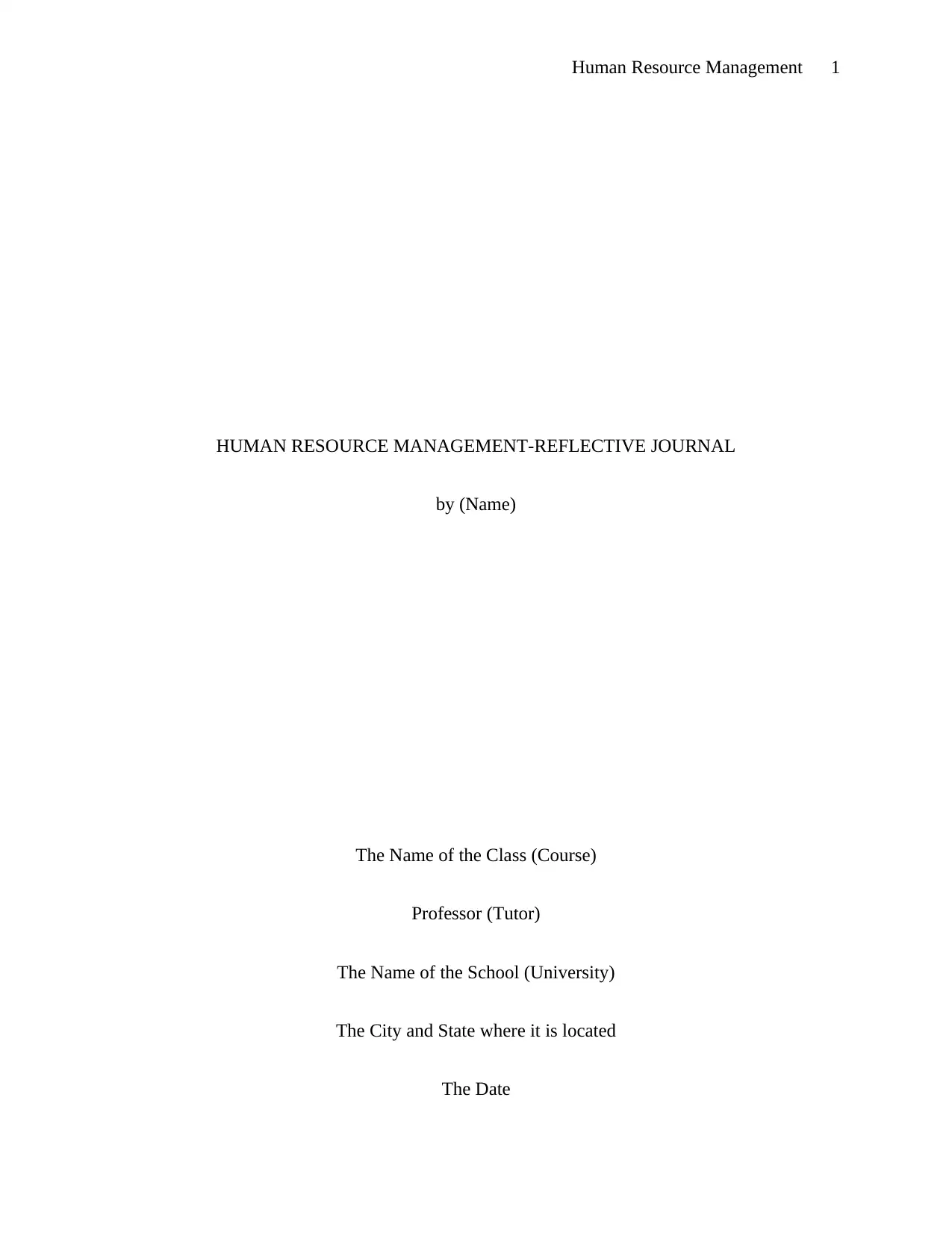
Human Resource Management 1
HUMAN RESOURCE MANAGEMENT-REFLECTIVE JOURNAL
by (Name)
The Name of the Class (Course)
Professor (Tutor)
The Name of the School (University)
The City and State where it is located
The Date
HUMAN RESOURCE MANAGEMENT-REFLECTIVE JOURNAL
by (Name)
The Name of the Class (Course)
Professor (Tutor)
The Name of the School (University)
The City and State where it is located
The Date
Paraphrase This Document
Need a fresh take? Get an instant paraphrase of this document with our AI Paraphraser
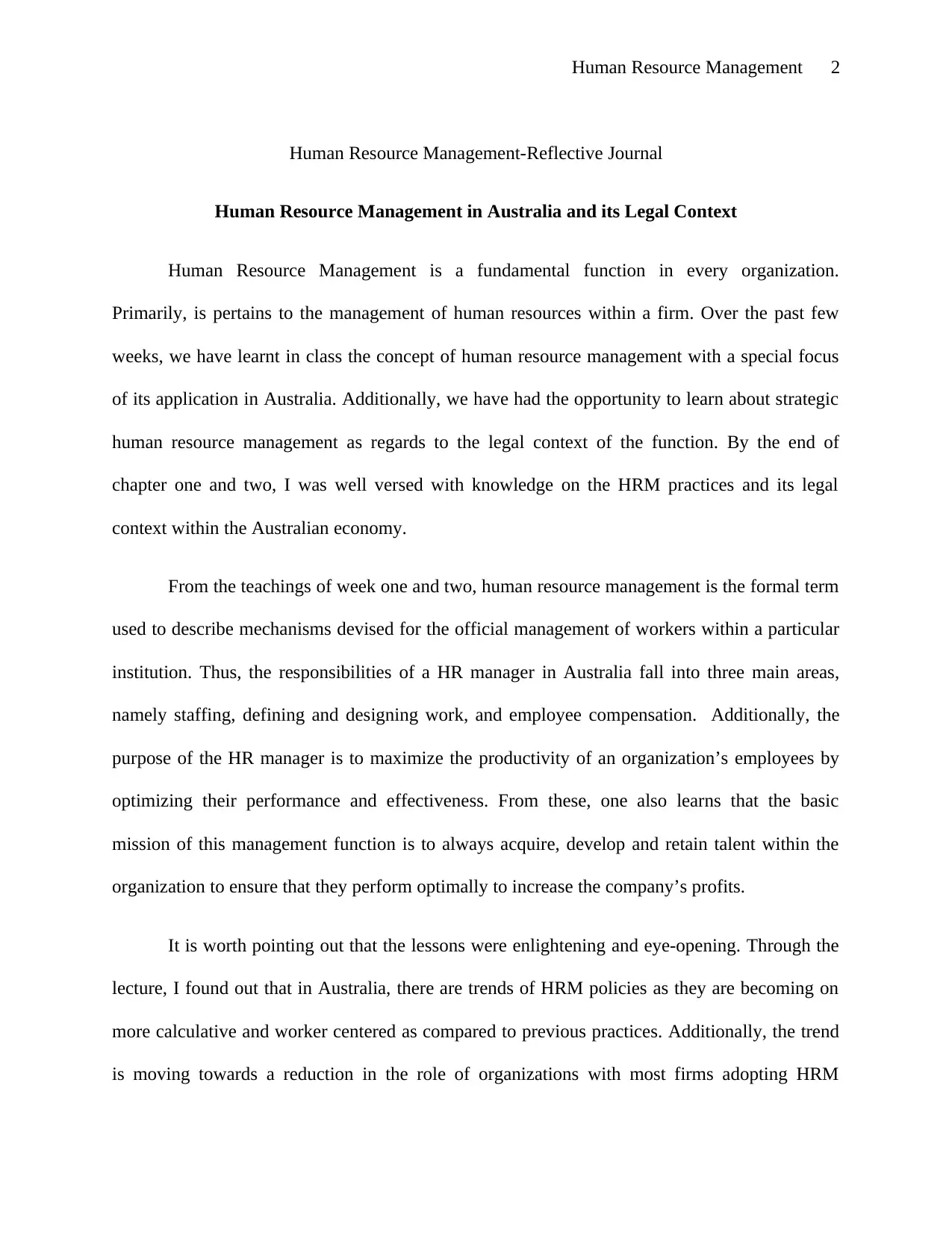
Human Resource Management 2
Human Resource Management-Reflective Journal
Human Resource Management in Australia and its Legal Context
Human Resource Management is a fundamental function in every organization.
Primarily, is pertains to the management of human resources within a firm. Over the past few
weeks, we have learnt in class the concept of human resource management with a special focus
of its application in Australia. Additionally, we have had the opportunity to learn about strategic
human resource management as regards to the legal context of the function. By the end of
chapter one and two, I was well versed with knowledge on the HRM practices and its legal
context within the Australian economy.
From the teachings of week one and two, human resource management is the formal term
used to describe mechanisms devised for the official management of workers within a particular
institution. Thus, the responsibilities of a HR manager in Australia fall into three main areas,
namely staffing, defining and designing work, and employee compensation. Additionally, the
purpose of the HR manager is to maximize the productivity of an organization’s employees by
optimizing their performance and effectiveness. From these, one also learns that the basic
mission of this management function is to always acquire, develop and retain talent within the
organization to ensure that they perform optimally to increase the company’s profits.
It is worth pointing out that the lessons were enlightening and eye-opening. Through the
lecture, I found out that in Australia, there are trends of HRM policies as they are becoming on
more calculative and worker centered as compared to previous practices. Additionally, the trend
is moving towards a reduction in the role of organizations with most firms adopting HRM
Human Resource Management-Reflective Journal
Human Resource Management in Australia and its Legal Context
Human Resource Management is a fundamental function in every organization.
Primarily, is pertains to the management of human resources within a firm. Over the past few
weeks, we have learnt in class the concept of human resource management with a special focus
of its application in Australia. Additionally, we have had the opportunity to learn about strategic
human resource management as regards to the legal context of the function. By the end of
chapter one and two, I was well versed with knowledge on the HRM practices and its legal
context within the Australian economy.
From the teachings of week one and two, human resource management is the formal term
used to describe mechanisms devised for the official management of workers within a particular
institution. Thus, the responsibilities of a HR manager in Australia fall into three main areas,
namely staffing, defining and designing work, and employee compensation. Additionally, the
purpose of the HR manager is to maximize the productivity of an organization’s employees by
optimizing their performance and effectiveness. From these, one also learns that the basic
mission of this management function is to always acquire, develop and retain talent within the
organization to ensure that they perform optimally to increase the company’s profits.
It is worth pointing out that the lessons were enlightening and eye-opening. Through the
lecture, I found out that in Australia, there are trends of HRM policies as they are becoming on
more calculative and worker centered as compared to previous practices. Additionally, the trend
is moving towards a reduction in the role of organizations with most firms adopting HRM
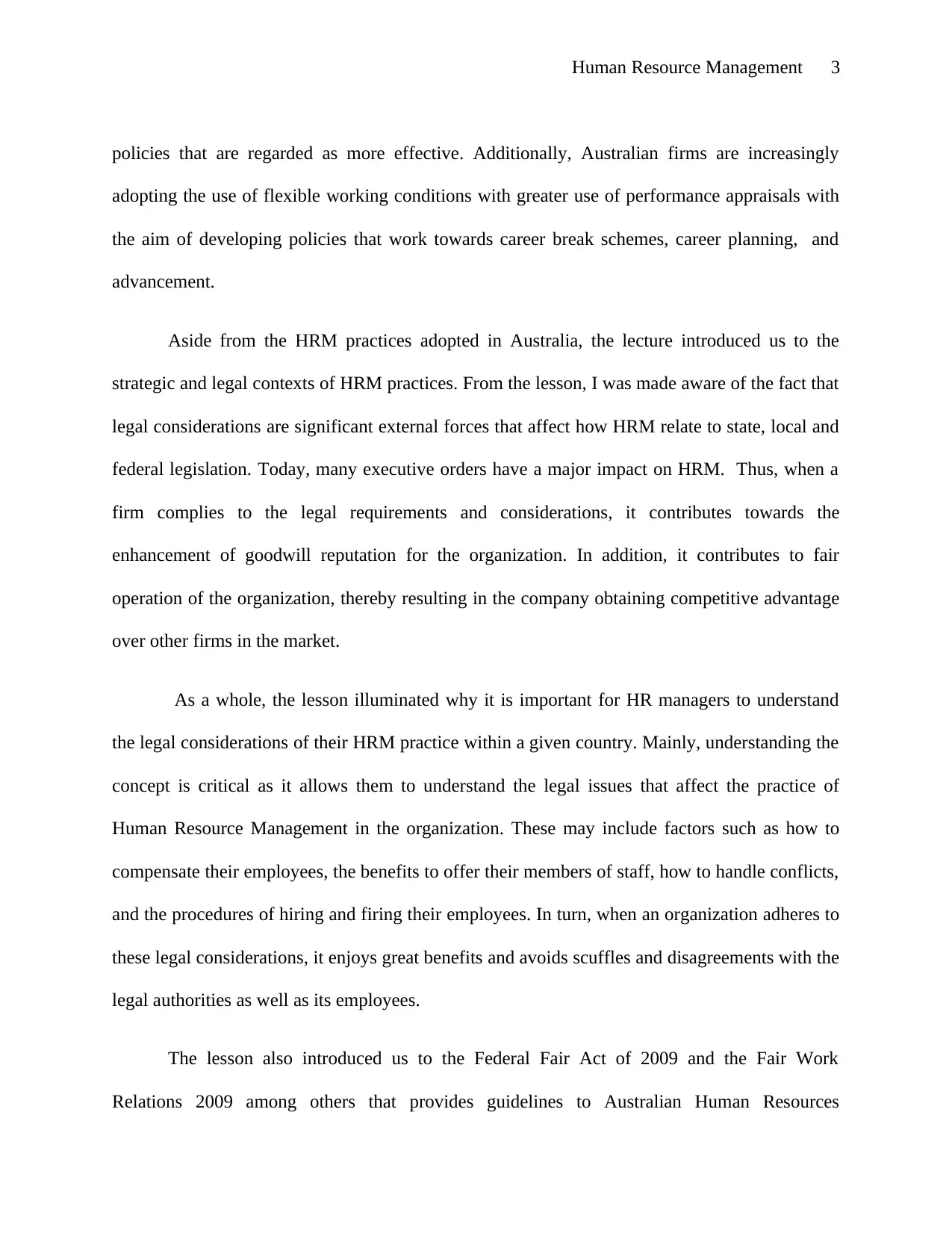
Human Resource Management 3
policies that are regarded as more effective. Additionally, Australian firms are increasingly
adopting the use of flexible working conditions with greater use of performance appraisals with
the aim of developing policies that work towards career break schemes, career planning, and
advancement.
Aside from the HRM practices adopted in Australia, the lecture introduced us to the
strategic and legal contexts of HRM practices. From the lesson, I was made aware of the fact that
legal considerations are significant external forces that affect how HRM relate to state, local and
federal legislation. Today, many executive orders have a major impact on HRM. Thus, when a
firm complies to the legal requirements and considerations, it contributes towards the
enhancement of goodwill reputation for the organization. In addition, it contributes to fair
operation of the organization, thereby resulting in the company obtaining competitive advantage
over other firms in the market.
As a whole, the lesson illuminated why it is important for HR managers to understand
the legal considerations of their HRM practice within a given country. Mainly, understanding the
concept is critical as it allows them to understand the legal issues that affect the practice of
Human Resource Management in the organization. These may include factors such as how to
compensate their employees, the benefits to offer their members of staff, how to handle conflicts,
and the procedures of hiring and firing their employees. In turn, when an organization adheres to
these legal considerations, it enjoys great benefits and avoids scuffles and disagreements with the
legal authorities as well as its employees.
The lesson also introduced us to the Federal Fair Act of 2009 and the Fair Work
Relations 2009 among others that provides guidelines to Australian Human Resources
policies that are regarded as more effective. Additionally, Australian firms are increasingly
adopting the use of flexible working conditions with greater use of performance appraisals with
the aim of developing policies that work towards career break schemes, career planning, and
advancement.
Aside from the HRM practices adopted in Australia, the lecture introduced us to the
strategic and legal contexts of HRM practices. From the lesson, I was made aware of the fact that
legal considerations are significant external forces that affect how HRM relate to state, local and
federal legislation. Today, many executive orders have a major impact on HRM. Thus, when a
firm complies to the legal requirements and considerations, it contributes towards the
enhancement of goodwill reputation for the organization. In addition, it contributes to fair
operation of the organization, thereby resulting in the company obtaining competitive advantage
over other firms in the market.
As a whole, the lesson illuminated why it is important for HR managers to understand
the legal considerations of their HRM practice within a given country. Mainly, understanding the
concept is critical as it allows them to understand the legal issues that affect the practice of
Human Resource Management in the organization. These may include factors such as how to
compensate their employees, the benefits to offer their members of staff, how to handle conflicts,
and the procedures of hiring and firing their employees. In turn, when an organization adheres to
these legal considerations, it enjoys great benefits and avoids scuffles and disagreements with the
legal authorities as well as its employees.
The lesson also introduced us to the Federal Fair Act of 2009 and the Fair Work
Relations 2009 among others that provides guidelines to Australian Human Resources
⊘ This is a preview!⊘
Do you want full access?
Subscribe today to unlock all pages.

Trusted by 1+ million students worldwide
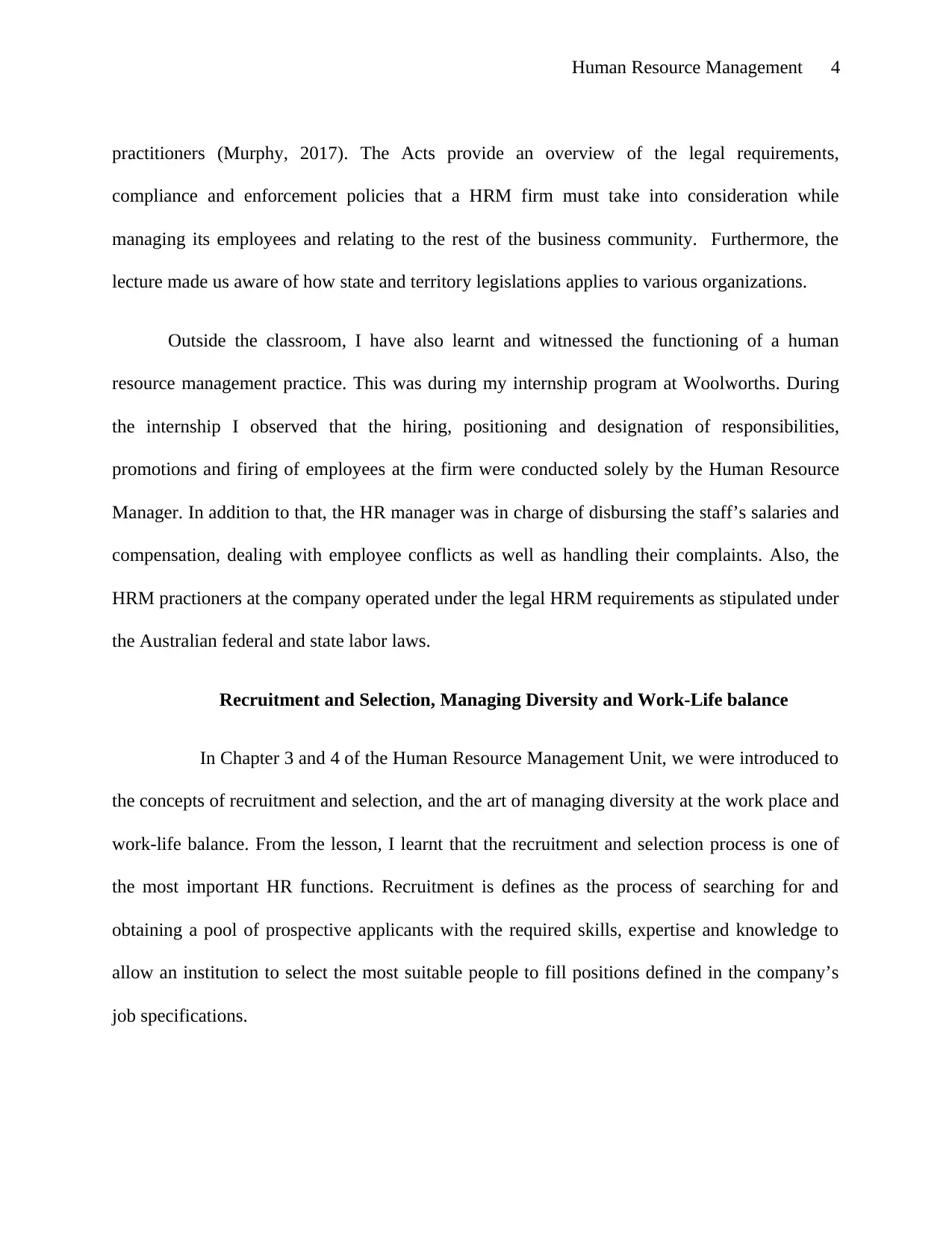
Human Resource Management 4
practitioners (Murphy, 2017). The Acts provide an overview of the legal requirements,
compliance and enforcement policies that a HRM firm must take into consideration while
managing its employees and relating to the rest of the business community. Furthermore, the
lecture made us aware of how state and territory legislations applies to various organizations.
Outside the classroom, I have also learnt and witnessed the functioning of a human
resource management practice. This was during my internship program at Woolworths. During
the internship I observed that the hiring, positioning and designation of responsibilities,
promotions and firing of employees at the firm were conducted solely by the Human Resource
Manager. In addition to that, the HR manager was in charge of disbursing the staff’s salaries and
compensation, dealing with employee conflicts as well as handling their complaints. Also, the
HRM practioners at the company operated under the legal HRM requirements as stipulated under
the Australian federal and state labor laws.
Recruitment and Selection, Managing Diversity and Work-Life balance
In Chapter 3 and 4 of the Human Resource Management Unit, we were introduced to
the concepts of recruitment and selection, and the art of managing diversity at the work place and
work-life balance. From the lesson, I learnt that the recruitment and selection process is one of
the most important HR functions. Recruitment is defines as the process of searching for and
obtaining a pool of prospective applicants with the required skills, expertise and knowledge to
allow an institution to select the most suitable people to fill positions defined in the company’s
job specifications.
practitioners (Murphy, 2017). The Acts provide an overview of the legal requirements,
compliance and enforcement policies that a HRM firm must take into consideration while
managing its employees and relating to the rest of the business community. Furthermore, the
lecture made us aware of how state and territory legislations applies to various organizations.
Outside the classroom, I have also learnt and witnessed the functioning of a human
resource management practice. This was during my internship program at Woolworths. During
the internship I observed that the hiring, positioning and designation of responsibilities,
promotions and firing of employees at the firm were conducted solely by the Human Resource
Manager. In addition to that, the HR manager was in charge of disbursing the staff’s salaries and
compensation, dealing with employee conflicts as well as handling their complaints. Also, the
HRM practioners at the company operated under the legal HRM requirements as stipulated under
the Australian federal and state labor laws.
Recruitment and Selection, Managing Diversity and Work-Life balance
In Chapter 3 and 4 of the Human Resource Management Unit, we were introduced to
the concepts of recruitment and selection, and the art of managing diversity at the work place and
work-life balance. From the lesson, I learnt that the recruitment and selection process is one of
the most important HR functions. Recruitment is defines as the process of searching for and
obtaining a pool of prospective applicants with the required skills, expertise and knowledge to
allow an institution to select the most suitable people to fill positions defined in the company’s
job specifications.
Paraphrase This Document
Need a fresh take? Get an instant paraphrase of this document with our AI Paraphraser
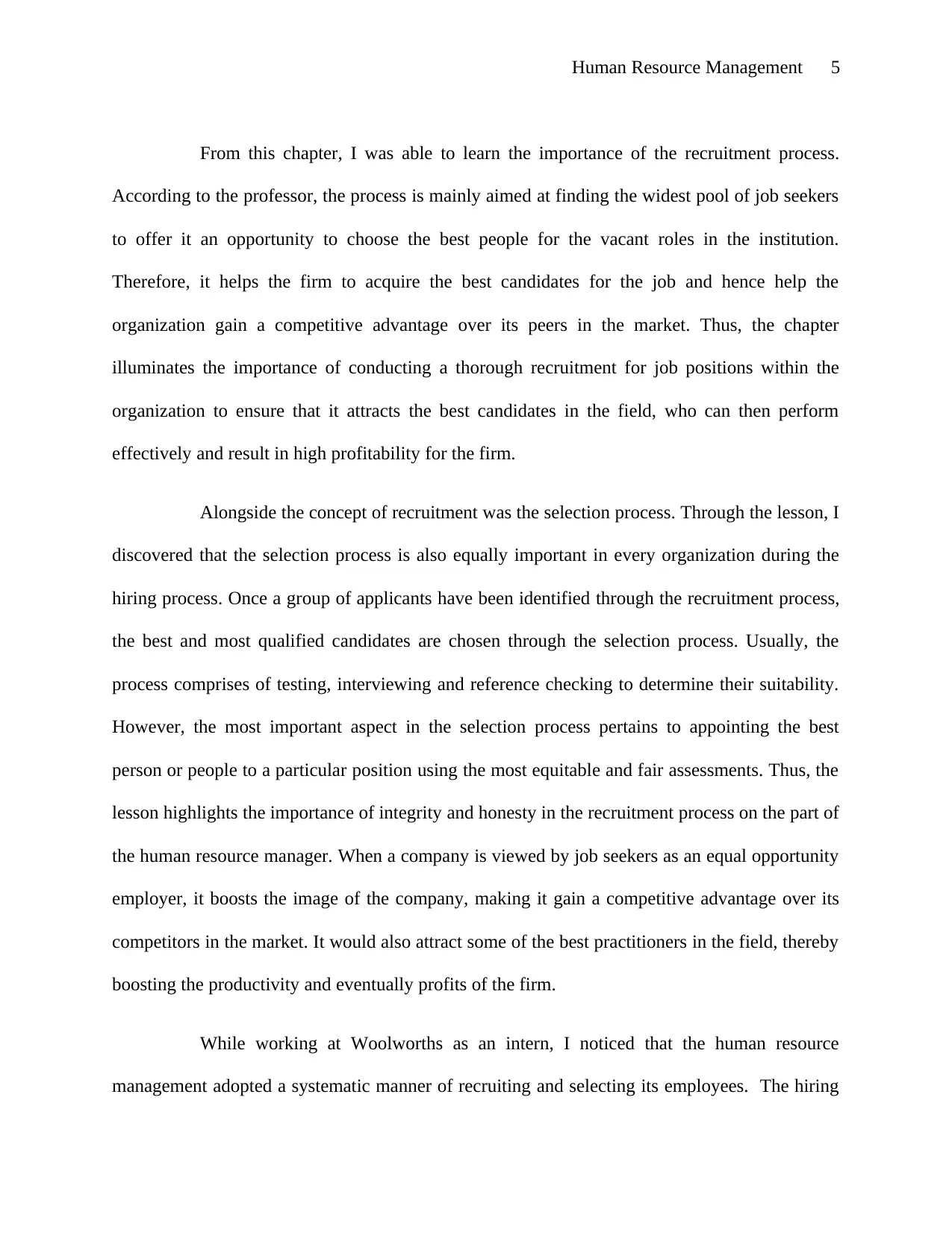
Human Resource Management 5
From this chapter, I was able to learn the importance of the recruitment process.
According to the professor, the process is mainly aimed at finding the widest pool of job seekers
to offer it an opportunity to choose the best people for the vacant roles in the institution.
Therefore, it helps the firm to acquire the best candidates for the job and hence help the
organization gain a competitive advantage over its peers in the market. Thus, the chapter
illuminates the importance of conducting a thorough recruitment for job positions within the
organization to ensure that it attracts the best candidates in the field, who can then perform
effectively and result in high profitability for the firm.
Alongside the concept of recruitment was the selection process. Through the lesson, I
discovered that the selection process is also equally important in every organization during the
hiring process. Once a group of applicants have been identified through the recruitment process,
the best and most qualified candidates are chosen through the selection process. Usually, the
process comprises of testing, interviewing and reference checking to determine their suitability.
However, the most important aspect in the selection process pertains to appointing the best
person or people to a particular position using the most equitable and fair assessments. Thus, the
lesson highlights the importance of integrity and honesty in the recruitment process on the part of
the human resource manager. When a company is viewed by job seekers as an equal opportunity
employer, it boosts the image of the company, making it gain a competitive advantage over its
competitors in the market. It would also attract some of the best practitioners in the field, thereby
boosting the productivity and eventually profits of the firm.
While working at Woolworths as an intern, I noticed that the human resource
management adopted a systematic manner of recruiting and selecting its employees. The hiring
From this chapter, I was able to learn the importance of the recruitment process.
According to the professor, the process is mainly aimed at finding the widest pool of job seekers
to offer it an opportunity to choose the best people for the vacant roles in the institution.
Therefore, it helps the firm to acquire the best candidates for the job and hence help the
organization gain a competitive advantage over its peers in the market. Thus, the chapter
illuminates the importance of conducting a thorough recruitment for job positions within the
organization to ensure that it attracts the best candidates in the field, who can then perform
effectively and result in high profitability for the firm.
Alongside the concept of recruitment was the selection process. Through the lesson, I
discovered that the selection process is also equally important in every organization during the
hiring process. Once a group of applicants have been identified through the recruitment process,
the best and most qualified candidates are chosen through the selection process. Usually, the
process comprises of testing, interviewing and reference checking to determine their suitability.
However, the most important aspect in the selection process pertains to appointing the best
person or people to a particular position using the most equitable and fair assessments. Thus, the
lesson highlights the importance of integrity and honesty in the recruitment process on the part of
the human resource manager. When a company is viewed by job seekers as an equal opportunity
employer, it boosts the image of the company, making it gain a competitive advantage over its
competitors in the market. It would also attract some of the best practitioners in the field, thereby
boosting the productivity and eventually profits of the firm.
While working at Woolworths as an intern, I noticed that the human resource
management adopted a systematic manner of recruiting and selecting its employees. The hiring
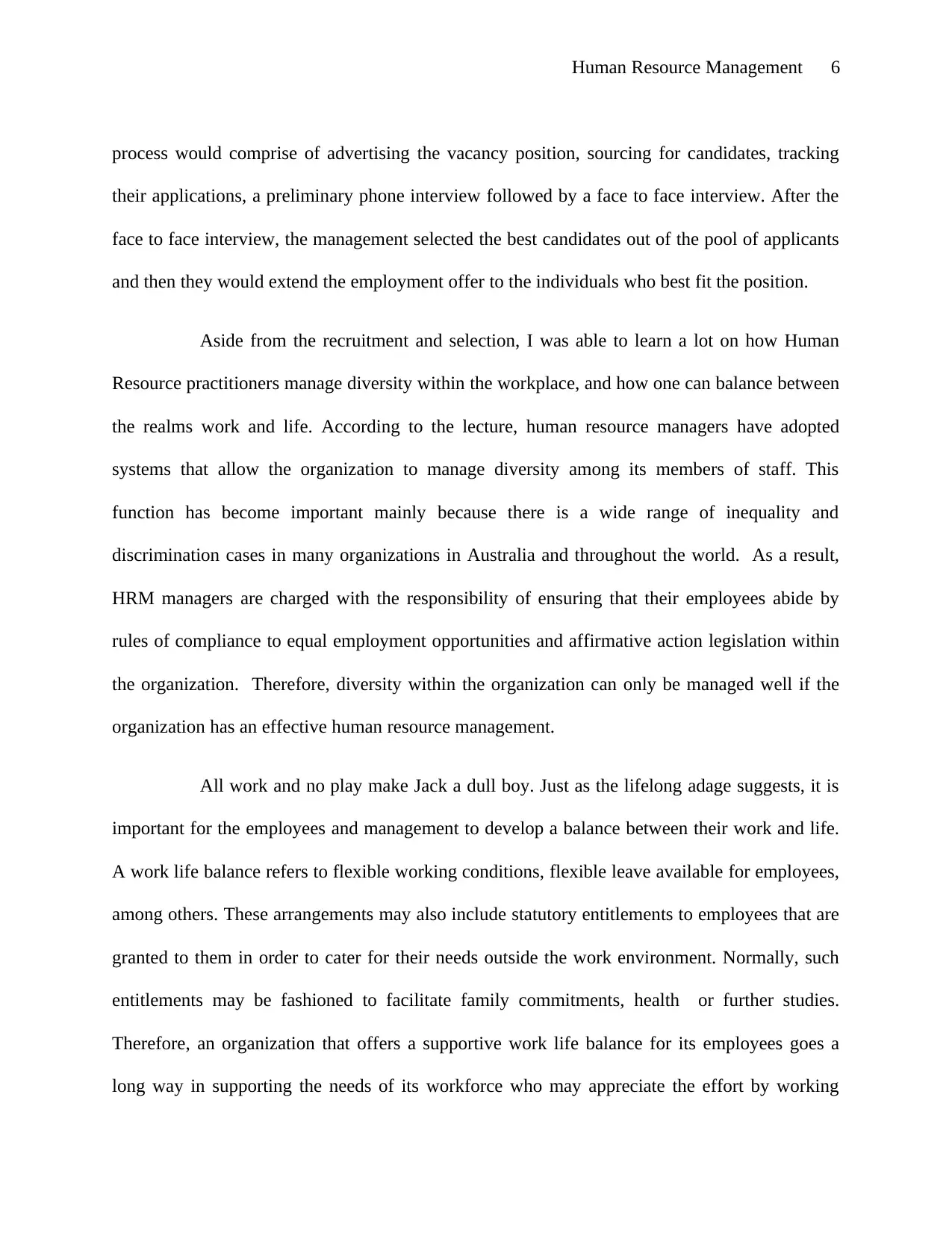
Human Resource Management 6
process would comprise of advertising the vacancy position, sourcing for candidates, tracking
their applications, a preliminary phone interview followed by a face to face interview. After the
face to face interview, the management selected the best candidates out of the pool of applicants
and then they would extend the employment offer to the individuals who best fit the position.
Aside from the recruitment and selection, I was able to learn a lot on how Human
Resource practitioners manage diversity within the workplace, and how one can balance between
the realms work and life. According to the lecture, human resource managers have adopted
systems that allow the organization to manage diversity among its members of staff. This
function has become important mainly because there is a wide range of inequality and
discrimination cases in many organizations in Australia and throughout the world. As a result,
HRM managers are charged with the responsibility of ensuring that their employees abide by
rules of compliance to equal employment opportunities and affirmative action legislation within
the organization. Therefore, diversity within the organization can only be managed well if the
organization has an effective human resource management.
All work and no play make Jack a dull boy. Just as the lifelong adage suggests, it is
important for the employees and management to develop a balance between their work and life.
A work life balance refers to flexible working conditions, flexible leave available for employees,
among others. These arrangements may also include statutory entitlements to employees that are
granted to them in order to cater for their needs outside the work environment. Normally, such
entitlements may be fashioned to facilitate family commitments, health or further studies.
Therefore, an organization that offers a supportive work life balance for its employees goes a
long way in supporting the needs of its workforce who may appreciate the effort by working
process would comprise of advertising the vacancy position, sourcing for candidates, tracking
their applications, a preliminary phone interview followed by a face to face interview. After the
face to face interview, the management selected the best candidates out of the pool of applicants
and then they would extend the employment offer to the individuals who best fit the position.
Aside from the recruitment and selection, I was able to learn a lot on how Human
Resource practitioners manage diversity within the workplace, and how one can balance between
the realms work and life. According to the lecture, human resource managers have adopted
systems that allow the organization to manage diversity among its members of staff. This
function has become important mainly because there is a wide range of inequality and
discrimination cases in many organizations in Australia and throughout the world. As a result,
HRM managers are charged with the responsibility of ensuring that their employees abide by
rules of compliance to equal employment opportunities and affirmative action legislation within
the organization. Therefore, diversity within the organization can only be managed well if the
organization has an effective human resource management.
All work and no play make Jack a dull boy. Just as the lifelong adage suggests, it is
important for the employees and management to develop a balance between their work and life.
A work life balance refers to flexible working conditions, flexible leave available for employees,
among others. These arrangements may also include statutory entitlements to employees that are
granted to them in order to cater for their needs outside the work environment. Normally, such
entitlements may be fashioned to facilitate family commitments, health or further studies.
Therefore, an organization that offers a supportive work life balance for its employees goes a
long way in supporting the needs of its workforce who may appreciate the effort by working
⊘ This is a preview!⊘
Do you want full access?
Subscribe today to unlock all pages.

Trusted by 1+ million students worldwide
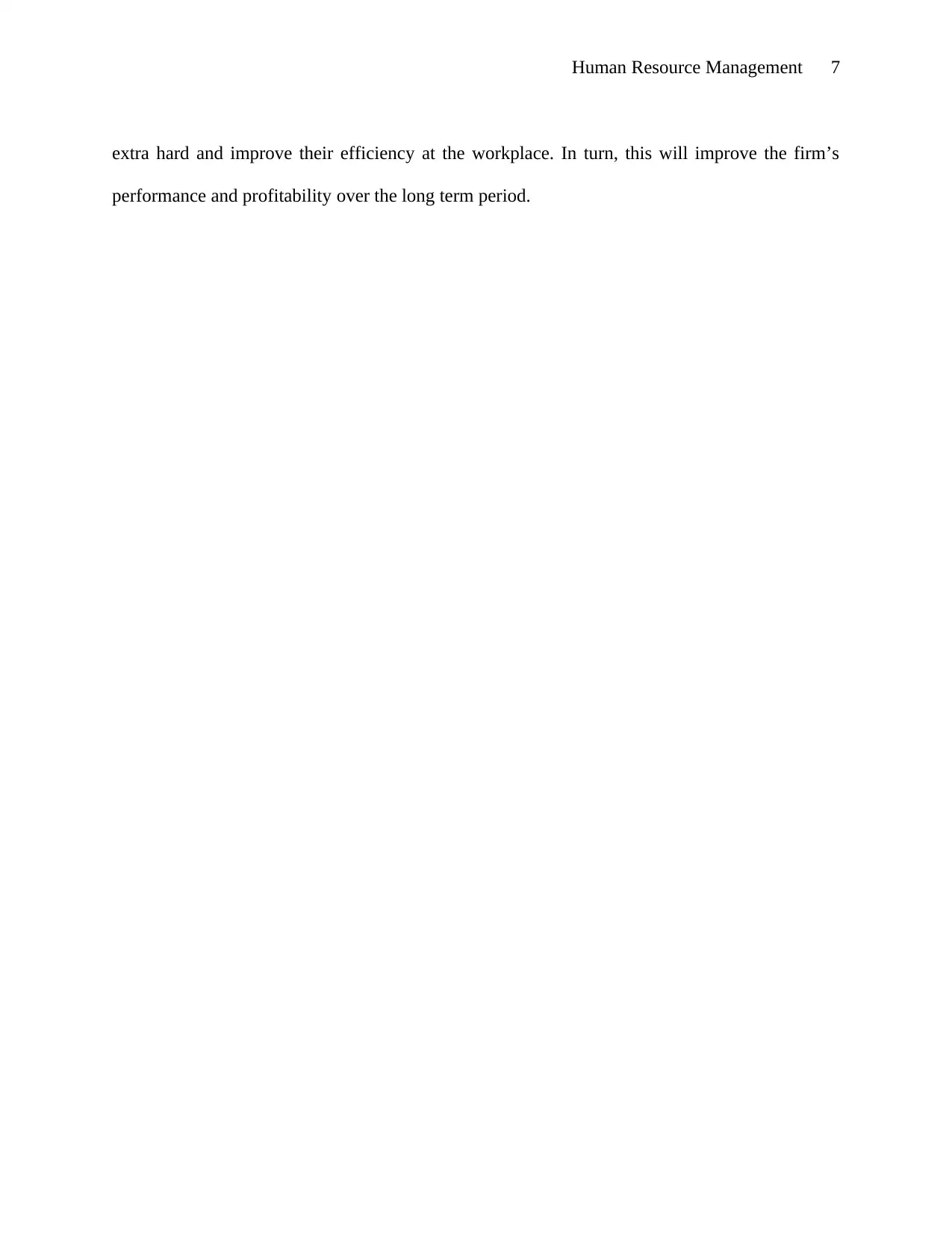
Human Resource Management 7
extra hard and improve their efficiency at the workplace. In turn, this will improve the firm’s
performance and profitability over the long term period.
extra hard and improve their efficiency at the workplace. In turn, this will improve the firm’s
performance and profitability over the long term period.
Paraphrase This Document
Need a fresh take? Get an instant paraphrase of this document with our AI Paraphraser
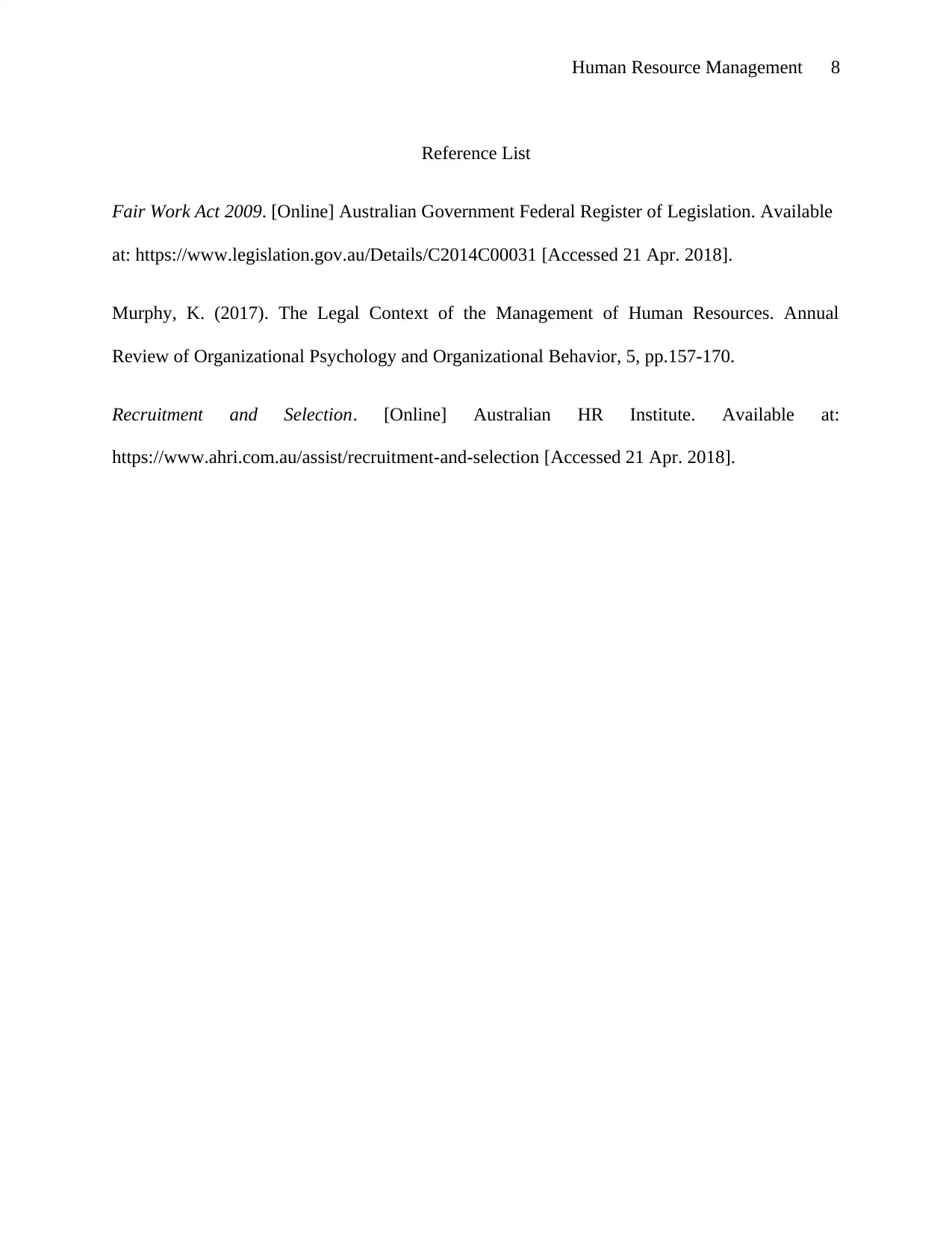
Human Resource Management 8
Reference List
Fair Work Act 2009. [Online] Australian Government Federal Register of Legislation. Available
at: https://www.legislation.gov.au/Details/C2014C00031 [Accessed 21 Apr. 2018].
Murphy, K. (2017). The Legal Context of the Management of Human Resources. Annual
Review of Organizational Psychology and Organizational Behavior, 5, pp.157-170.
Recruitment and Selection. [Online] Australian HR Institute. Available at:
https://www.ahri.com.au/assist/recruitment-and-selection [Accessed 21 Apr. 2018].
Reference List
Fair Work Act 2009. [Online] Australian Government Federal Register of Legislation. Available
at: https://www.legislation.gov.au/Details/C2014C00031 [Accessed 21 Apr. 2018].
Murphy, K. (2017). The Legal Context of the Management of Human Resources. Annual
Review of Organizational Psychology and Organizational Behavior, 5, pp.157-170.
Recruitment and Selection. [Online] Australian HR Institute. Available at:
https://www.ahri.com.au/assist/recruitment-and-selection [Accessed 21 Apr. 2018].
1 out of 8
Related Documents
Your All-in-One AI-Powered Toolkit for Academic Success.
+13062052269
info@desklib.com
Available 24*7 on WhatsApp / Email
![[object Object]](/_next/static/media/star-bottom.7253800d.svg)
Unlock your academic potential
Copyright © 2020–2025 A2Z Services. All Rights Reserved. Developed and managed by ZUCOL.





